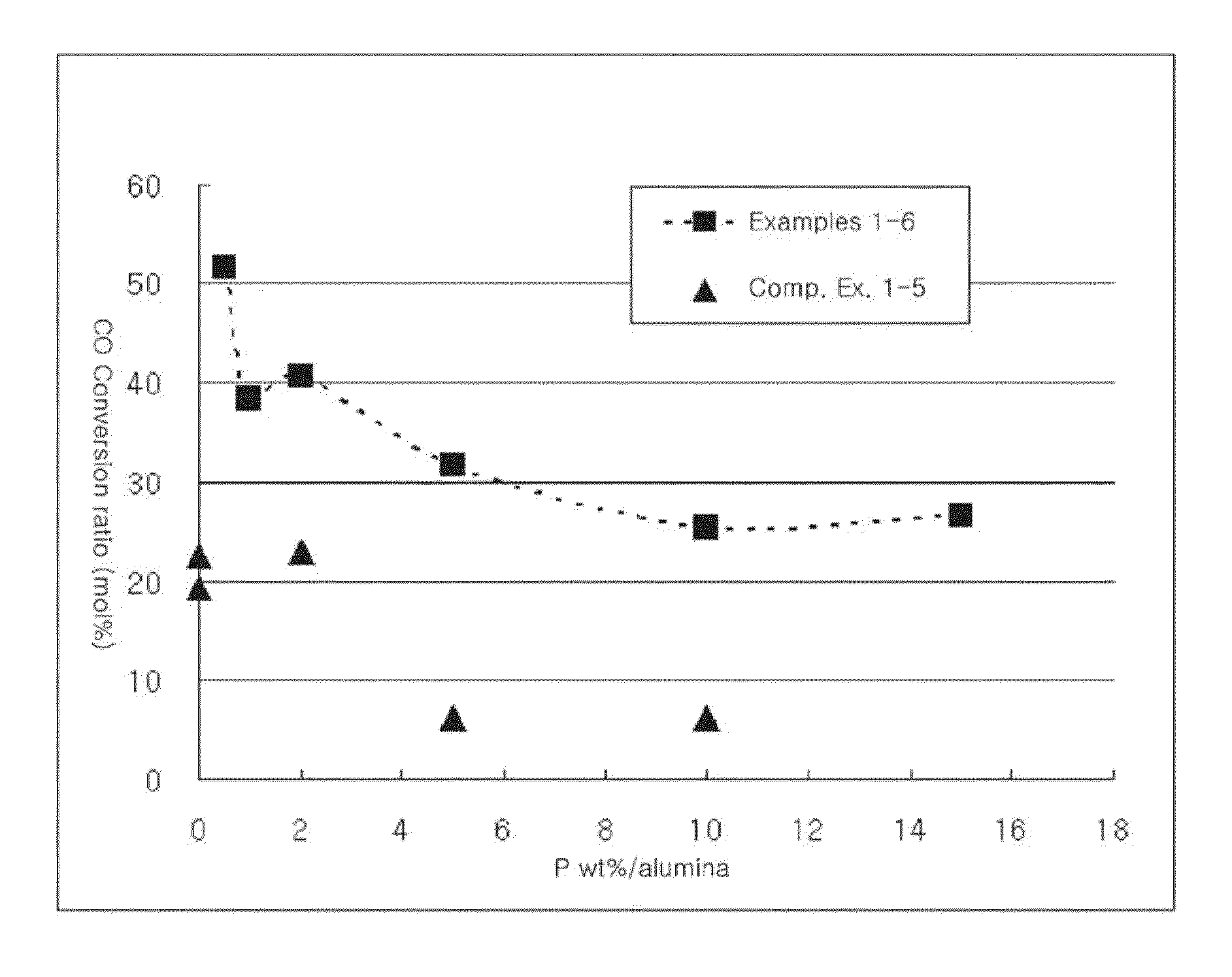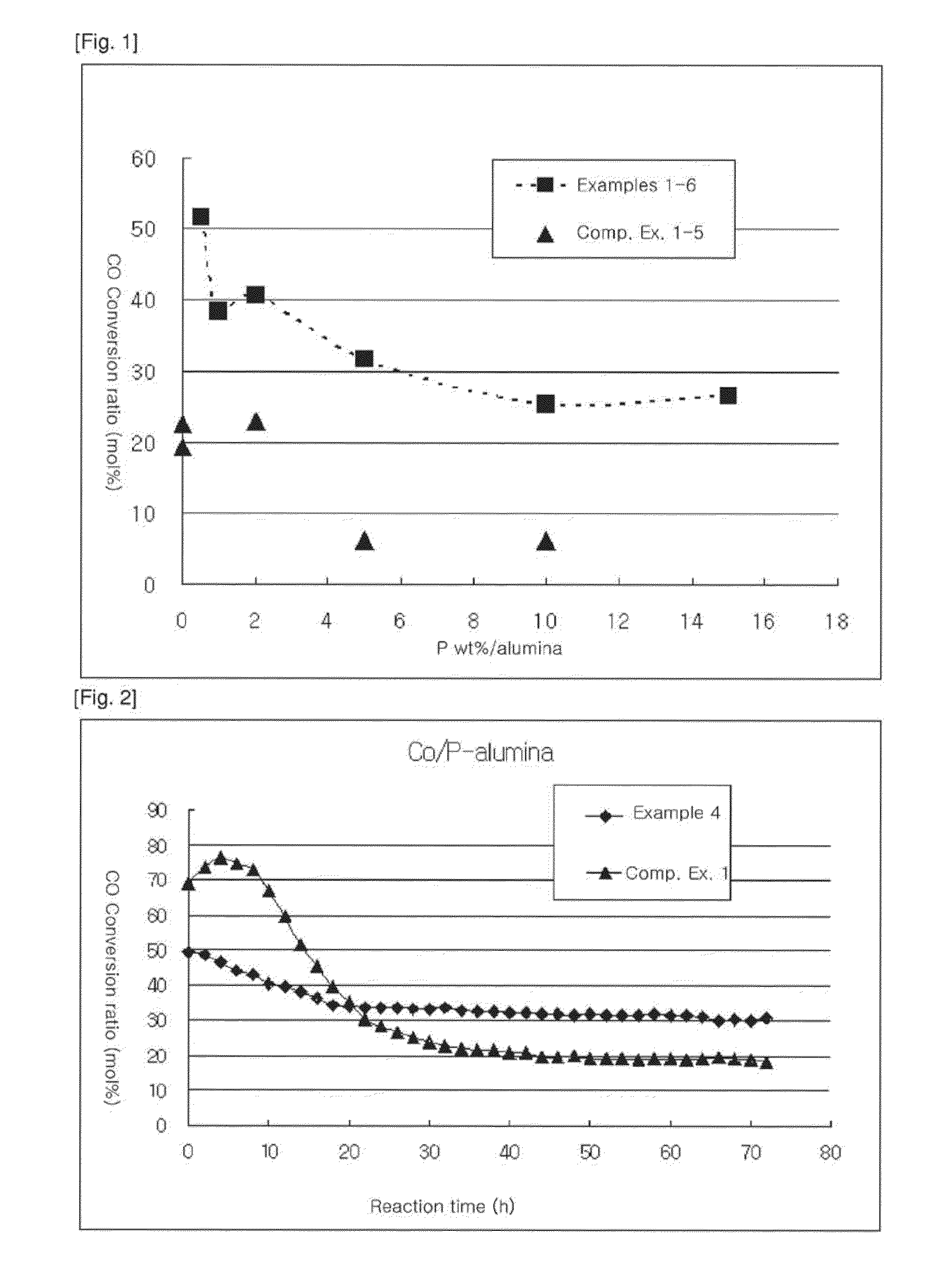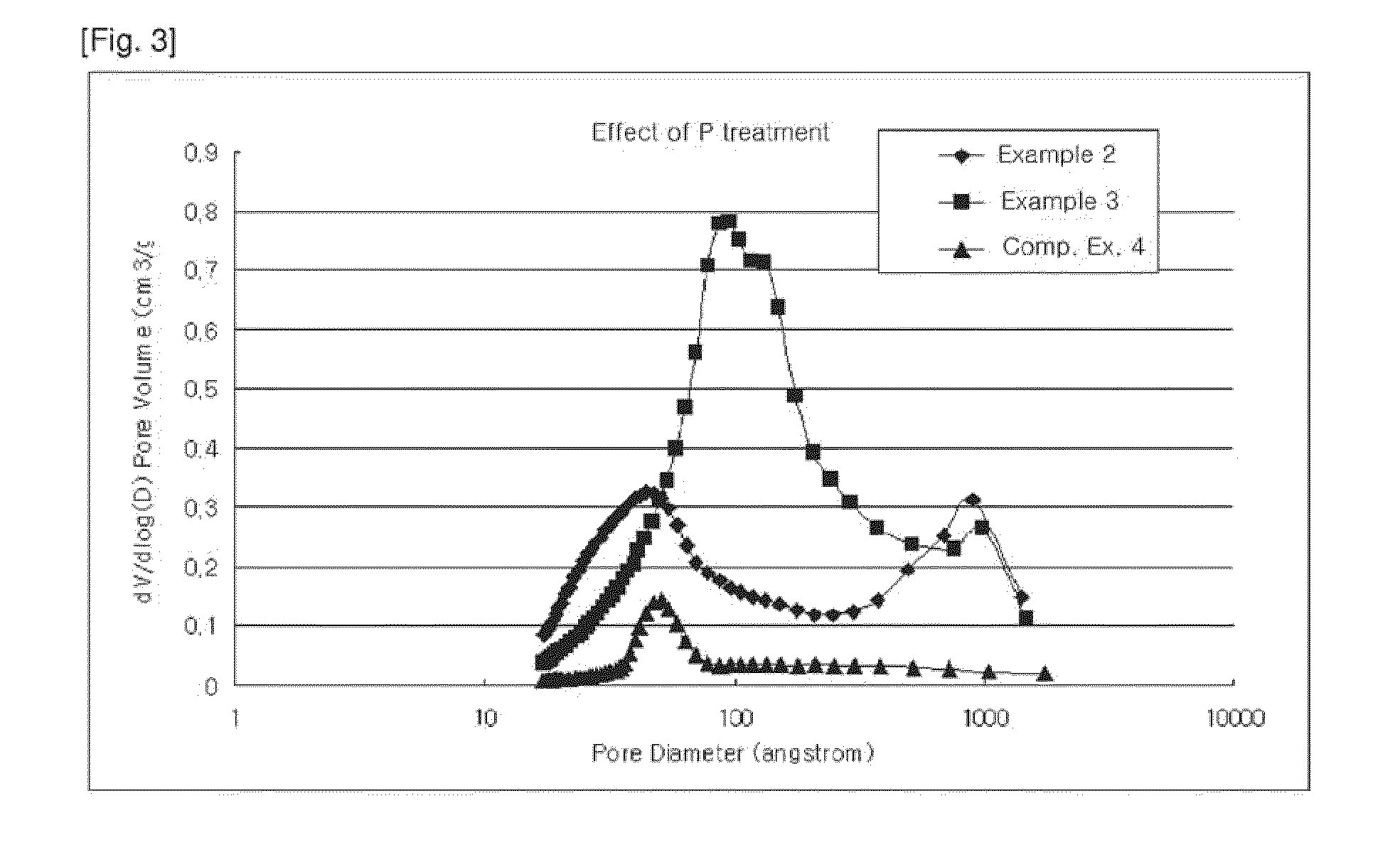Catalysts for fischer-tropsch synthesis on cobalt/phosphorus-aluminum oxide and preparation methods thereof
a technology of cobalt/phosphorus-aluminum oxide and catalyst, which is applied in the direction of catalyst activation/preparation, metal/metal-oxide/metal-hydroxide catalyst, physical/chemical process catalyst, etc., can solve the problems of reduced thermal stability and inactivation of catalyst, and achieve optimized f-t reaction, improved thermal efficiency and carbon utilization, and stable selectivity of liquid hydrocarbons
- Summary
- Abstract
- Description
- Claims
- Application Information
AI Technical Summary
Benefits of technology
Problems solved by technology
Method used
Image
Examples
example 1
[0055]Alumina having a large surface area was prepared by sol-gel method. Acetic acid and water were added to the slurry prepared by mixing aluminum isopropoxide with a 2-propanol solution. Amorphous aluminum hydroxide was obtained through hydrolysis. The molar proportion of the reactants aluminum isopropoxide, 2-propanol, acetic acid and water was maintained at 1:25:0.1:3. The prepared slurry solution was aged at 90° C. and 1 atm for 20 hours while refluxing 2-propanol. Then, a boehmite powder was attained by drying in an oven kept at 100° C. The boehmite powder was baked at 500° C. for 5 hours to obtain alumina having a large surface area (specific surface area=455 m2 / g).
[0056]For 5 g of the prepared alumina, 0.093 g of phosphoric acid (H3PO4) was dissolved in 60 mL of water to prepare phosphorus-supported alumina, which was baked at 500° C. for 5 hours to prepare a phosphorus-alumina support in the form of powder. The prepared phosphorus-alumina support had a specific surface are...
example 2
[0059]A cobalt / phosphorus-alumina catalyst was prepared in the same manner as in Example 1, except for using 0.186 g of phosphoric acid (H3PO4) per 5 g of alumina to prepare a phosphorus-supported alumina and supporting 3.055 g of cobalt nitrate (Co(NO3)2.6H2O). The composition of the catalyst was 20 wt % Co / 1.0 wt % P-γ-Al2O3 based on metal weight and the final specific surface area was 201 m2 / g.
[0060]0.3 g of the catalyst was put in a ½-inch stainless steel fixed bed reactor and reduced for 12 hours under hydrogen atmosphere (5 vol % H2 / He) at 400° C. prior to performing reaction. Subsequently, the reactants carbon monoxide, hydrogen, carbon dioxide and argon (internal standard) were supplied to the reactor at a fixed molar proportion of 28.4:57.3:9.3:5 under the condition of: reaction temperature=220° C.; reaction pressure=20 kg / cm2; and space velocity=2000 L / kg cat / hr. The Fischer-Tropsch reaction result is summarized in Table 1. The steady-state condition was obtained after aro...
example 3
[0061]A cobalt / phosphorus-alumina catalyst was prepared in the same manner as in Example 1, except for using 0.372 g of phosphoric acid (H3PO4) per 5 g of alumina to prepare a phosphorus-supported alumina and supporting 3.055 g of cobalt nitrate (Co(NO3)2.6H2O). The composition of the catalyst was 20 wt % Co / 2.0 wt % P-γ-Al2O3 based on metal weight and the final specific surface area was 222 m2 / g.
[0062]0.3 g of the catalyst was put in a ½-inch stainless steel fixed bed reactor and reduced for 12 hours under hydrogen atmosphere (5 vol % H2 / He) at 400° C. prior to performing reaction. Subsequently, the reactants carbon monoxide, hydrogen, carbon dioxide and argon (internal standard) were supplied to the reactor at a fixed molar proportion of 28.4:57.3:9.3:5 under the condition of: reaction temperature=220° C.; reaction pressure=20 kg / cm2; and space velocity=2000 L / kg cat / hr. The Fischer-Tropsch reaction result is summarized in Table 1. The steady-state condition was obtained after aro...
PUM
| Property | Measurement | Unit |
|---|---|---|
| specific surface area | aaaaa | aaaaa |
| pKa | aaaaa | aaaaa |
| specific surface area | aaaaa | aaaaa |
Abstract
Description
Claims
Application Information
 Login to View More
Login to View More - R&D
- Intellectual Property
- Life Sciences
- Materials
- Tech Scout
- Unparalleled Data Quality
- Higher Quality Content
- 60% Fewer Hallucinations
Browse by: Latest US Patents, China's latest patents, Technical Efficacy Thesaurus, Application Domain, Technology Topic, Popular Technical Reports.
© 2025 PatSnap. All rights reserved.Legal|Privacy policy|Modern Slavery Act Transparency Statement|Sitemap|About US| Contact US: help@patsnap.com



